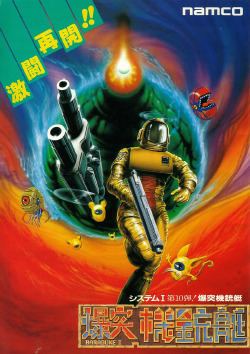Genre Shoot 'em up | Initial release date August 1988 Publisher Namco | |
 | ||
Composer(s) Norio NakagataTakane Ohkubo Release date(s) ArcadeJP: August 1988Wii Virtual ConsoleJP: October 13, 2009 Mode(s) Up to 2 players, alternating turns Cabinet Upright, cabaret, and cocktail CPU Motorola M6809Hitachi HD63701 Similar Baraduke, Pistol Daimyo no Bōken, Rompers, Hopping Mappy, Thunder Ceptor | ||
Bakutotsu Kijūtei (爆突機銃艇, Bakutotsu Kijūtei, lit. "Bomb Thrust Machine Gun Vessel"), also known by its longer title as Bakutotsu Kijūtei: Baraduke II, is a scrolling shooter arcade game that was released by Namco in 1988 only in Japan, and for the Virtual Console in 2009. It runs on Namco System 1 hardware, and is the sequel to Baraduke, which was released three years earlier. It was also the second game from the company to allow scores not ending in "0" (the first was Hopping Mappy released in 1986), along with the first one to display Katakana in bold text onscreen to distinguish it from Hiragana.
Contents
Bakutotsu kij tei baraduke ii ost game over
Gameplay
As in the original game, the players again take control of Takky (Player 1) and Hommy (Player 2) while fighting the strange-looking Octy and saving the one-eyed Paccets. Several new enemies have also been introduced (one of which, the "Block Brain", first appeared in Beraboh Man, and another, the "Black Paccet", is an evil version of the Paccets). There are now four different types of capsules; as a general rule, the yellow ones contain Paccets, while the red ones contain Baganns (the Pac-Man-like aliens from the original title), the blue ones contain shot powerups, and the green ones contain speed powerups. It is also now impossible to move backwards (like in Super Mario Bros.). If the players die, they will be sent back to the beginning of the stage (unlike in the original, where they would restart in the place where they died) and be reprimanded by the "Paccet Ojisan", who also appears for the start of some stages to give advice in Japanese.
